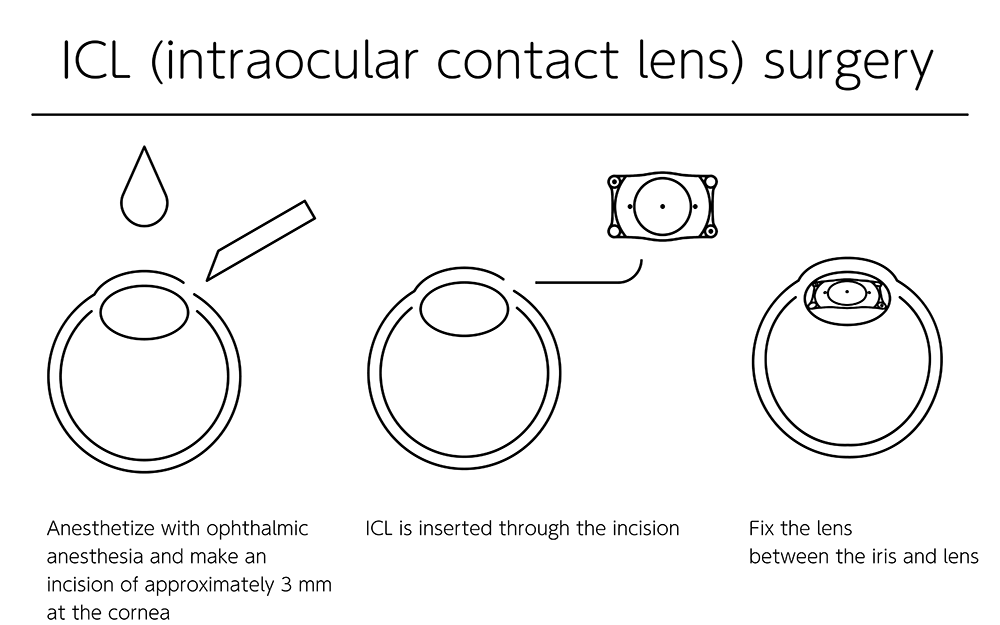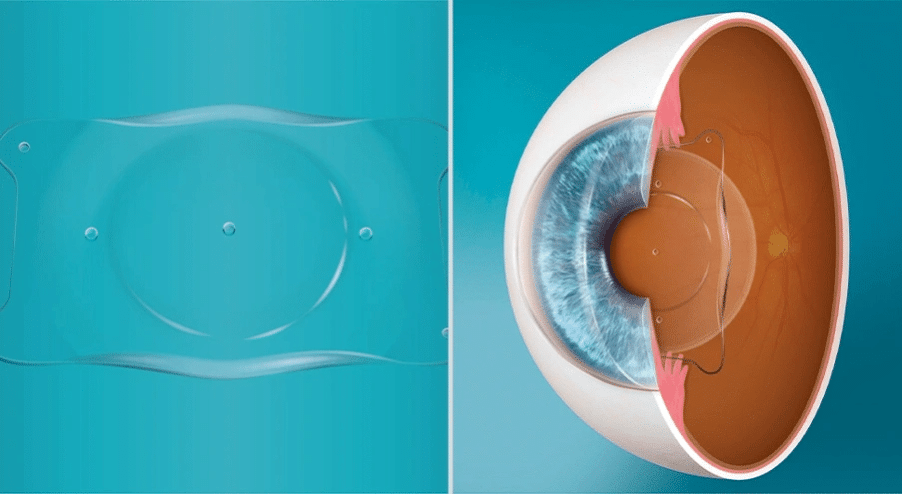You need to think over ICL surgery risks before learning about vision correction options beyond traditional laser treatments. At the time ICL (Implantable Collamer Lens) surgery gained popularity, the procedure showed a 0.1-3.2% risk of developing glaucoma within the first two years after treatment. Studies also show a 2.07% chance of rhegmatogenous retinal detachment that typically happens about 29 months after surgery.
But knowing what ICL eye surgery actually involves helps you decide if this procedure suits your needs. ICL technology has improved by a lot since doctors first used it in the 1990s. Some patients see glare and haloes around lights, especially when they’re in dim lighting. You should understand the benefits and potential risks of this eye surgery in London before moving forward.

Understanding ICL Surgery and Its Purpose
ICL surgery is a breakthrough alternative that helps patients break free from glasses and contact lenses. This option works great, especially when you have conditions that make laser eye procedures impossible. Let’s look at what makes this advanced vision correction method special and who can benefit from it.
What does ICL stand for?
ICL means Implantable Collamer Lens – a biocompatible lens that combines collagen with polymeric material. The lens’s unique makeup creates flexibility similar to your cornea’s natural collagen. This makes it work perfectly with your eye’s structure. The collamer material weighs very little, attracts water, and lets gases and nutrients flow through. These features give it an edge over other lens materials.
How ICL eye surgery works
ICL surgery adds a lens instead of reshaping your cornea like laser procedures do. Your corneal tissue stays completely untouched. A specialised eye surgeon makes a tiny cut in your eye and places the Collamer lens between your natural lens and iris – the coloured part of your eye. The lens sits in this perfect spot and works with your eye’s natural lens. Together they bend light correctly onto the retina to create clear vision. You’ll be happy to know the whole procedure takes just 20-30 minutes.
Who is a good candidate for ICL?
ICL surgery works best for:
- Patients between 21-45 years old with stable vision (no changes for about a year)
- People who have moderate to severe nearsightedness (up to -20 diopters) or astigmatism (up to 4 diopters)
- Anyone with thin corneas or dry eyes that rule out laser procedures
- Those who want a reversible option – unlike laser treatments, doctors can remove ICL if needed
Your eye’s anterior chamber depth and overall health need careful evaluation before moving forward. Your eyes must be free from major diseases like cataracts, glaucoma, or severe dry eye conditions that could affect the ICL procedure’s success. Precision Vision London gives you a full picture through pre-operative assessment. This advanced technology helps only those who will truly benefit from it. Our UK-trained surgeons guide you through every step of your vision correction experience.
The Most Common ICL Surgery Risks
ICL surgery’s potential complications are vital to think over. Every surgery has risks, but with the right team, they can be managed safely. Let’s get into the most common concerns that patients face with this procedure.
1. Elevated intraocular pressure and glaucoma
High intraocular pressure makes up about 10.8% of post-ICL complications. Patients often experience the first pressure spike during the first postoperative day because of retained viscoelastic material. Steroid-induced ocular hypertension causes about 64% of IOP elevation cases. Most patients’ pressure levels return to normal, but secondary glaucoma might develop up to 8 years after surgery in rare cases.

2. Cataract development over time
Cataract formation stands as one of the most documented ICL complications. Research shows a 1.96% incidence of clinically significant cataracts within 5 years after surgery. Risk factors include:
- Age over 40 years at implantation
- High myopia exceeding -12 diopters
- Shallow anterior chamber depth
- Low vault (space between ICL and natural lens)
Newer EVO ICL models with central flow ports have helped reduce this risk.
3. Night vision disturbances (halos, glare)
About 68.8% of patients experience halos and 43.8% report starbursts right after surgery. These visual disturbances usually fade over time dropping from 39% at one month to 15% at twelve months. These symptoms can occur when the pupil diameter doesn’t match the ICL optical zone.
4. Risk of infection or inflammation
Endophthalmitis is a serious yet rare complication with an incidence of about 0.0167%. Patients might experience infectious and aseptic inflammatory reactions that need quick treatment.
5. Lens dislocation or rotation
While ICL dislocation rarely happens, it can lead to long-term complications. This might happen due to improper sizing, leftover viscoelastic material, or trauma. Around 9.375% of toric ICL patients experience axis rotation beyond 10° and need repositioning.
6. Loss of corneal endothelial cells
The corneal endothelium helps maintain corneal clarity. Research shows endothelial cell density loss ranges from 2% to 9% after ICL implantation. Higher vault values relate to greater cell loss, but significant decompensation remains rare with proper sizing and regular monitoring.
Less Common but Serious Complications
Patients should know about rare but serious risks beyond the usual complications. Expert management plays a crucial role to achieve the best outcomes in these sight-threatening problems.
Retinal detachment in high myopia patients
High myopia patients face rhegmatogenous retinal detachment in approximately 2.07% of ICL recipients. This typically shows up around 29 months after surgery. The sudden decompression of the anterior chamber during surgery causes posterior vitreous detachment that pulls on the retina. Research shows that modern EVO ICL implantation might not raise long-term retinal detachment risk compared to other correction methods.
Urrets-Zavalia syndrome and fixed pupil
This rare condition shows up as a fixed, dilated pupil and raised intraocular pressure. Viscoelastic agent retention leads to iris ischemia, and patients experience persistent glare, halos, and light sensitivity. Doctors can predict possible recovery by checking immediate pressure control, light reactivity of the dilated pupil, and how well the eye responds to pilocarpine drops.
Macular oedema and visual distortion
Cystoid macular oedema can appear as early as the first day after surgery. This causes metamorphopsia (visual distortion). The ICL rubbing against the iris, posterior vitreous detachment, or inflammatory processes might trigger this condition. The good news is that most patients respond well to topical treatment.
Pigment dispersion and secondary glaucoma
When the iris experiences friction, it releases pigment that can build up in the trabecular meshwork. This might lead to secondary glaucoma even 8-13 years after surgery. Doctors must monitor patients long-term because this delayed complication can cause permanent visual field loss if left undetected.
How Precision Vision London Minimises These Risks
Safety is the top priority at Precision Vision London. The clinic has several specialised protocols that keep ICL surgery risks at a minimum.
Advanced pre-operative screening and imaging
Each consultation takes about 90 minutes. You’ll get a complete set of tests that has corneal tomography scanning, pupil measurements, and a full examination of your retina. The advanced biometric testing shows your anterior chamber depth to check if ICL is right for you. This careful screening makes sure only the right candidates move forward with surgery.

Use of EVO ICL to reduce pressure-related risks
The modern EVO ICL design has a central hole that keeps natural aqueous humour flowing. This prevents high eye pressure after surgery. Studies show the average IOP stays normal after implantation without any notable spikes. The new design makes peripheral iridotomies almost unnecessary.
Highly experienced surgeons with UK-based training
Patient outcomes improve by a lot with experienced refractive surgeons. The consultant-led teams at Precision Vision London are among the UK’s most respected ICL surgeons. Their skill in this delicate procedure shows in their exceptional safety record.
Post-operative care and long-term monitoring
You’ll have scheduled check-ups after surgery: one day, one week, one month, and three months. Yearly follow-ups help monitor your lens position and eye health. These reviews include endothelial cell density checks and vault measurements at no extra cost.
Customised lens sizing and placement
The right lens size is vital to avoid complications. We use advanced imaging technologies to measure the exact space inside your eye where the lens will sit. This gives us more accurate information than just estimating size from external measurements.
Our expert surgeons at Precision Vision London explain ICL surgery’s risks honestly. They provide the safest, most advanced solutions to protect your vision. Book your ICL consultation today and learn about the benefits and risks before making your decision.
Conclusion
ICL surgery risks are rare when handled by experienced specialists. This piece covers both common and rare complications ranging from raised eye pressure to retinal detachment. Proper patient selection, advanced technology, and expert surgical technique can substantially lower these risks. The rise of ICL technology, especially the EVO design with its central flow port, has without doubt reduced many older concerns about pressure-related complications. Precision Vision London’s careful pre-operative screening makes sure only the right candidates get this life-changing procedure.
The surgeon you choose plays the most crucial role in safety outcomes. Precision Vision London has UK-trained consultant ophthalmologists who focus only on ICL procedures. Their detailed 90-minute original assessment gives exact measurements needed for the best lens sizing and placement. Safety doesn’t end in the operating room. The clinic’s well-laid-out follow-up programme tracks your recovery at specific times – one day, one week, one month, three months, and yearly after that. This alertness helps catch any possible complications before they impact your vision.
Every surgery comes with some risk. Yet ICL surgery by qualified professionals gives amazing visual results to many patients who couldn’t get laser correction before. Book a consultation with Precision Vision London to learn if this procedure matches your specific visual needs and eye structure. Clear vision is truly a precious gift that deserves the highest level of care from professionals who focus on your safety and satisfaction.
FAQs
Q1. What are the most common risks associated with ICL surgery? The most common risks include elevated intraocular pressure, cataract development, night vision disturbances, infection or inflammation, lens dislocation, and loss of corneal endothelial cells. However, these risks are generally low and can be minimised with proper screening and experienced surgeons.
Q2. How long does it typically take to recover from ICL surgery? Most patients recover fully within four weeks after ICL surgery. Vision improvement is often noticeable within days, but it’s important to attend follow-up appointments to ensure proper healing and address any concerns.
Q3. Are there any activities I should avoid after ICL surgery? For the first week or two following surgery, it’s advisable to avoid heavy lifting and strenuous activities. Your surgeon will guide you on gradually resuming normal activities, including driving and returning to work, based on your individual recovery progress.
Q4. Who is considered an ideal candidate for ICL surgery? Ideal candidates are typically between 21 and 45 years old with stable vision prescriptions. ICL is particularly suitable for those with moderate to severe nearsightedness or astigmatism, and individuals who may not qualify for laser procedures due to thin corneas or dry eyes.
Q5. How does Precision Vision London ensure patient safety during ICL procedures? Precision Vision London prioritises safety through comprehensive pre-operative screening, use of advanced EVO ICL technology, highly experienced UK-trained surgeons, customised lens sizing, and thorough post-operative care including long-term monitoring. These measures significantly reduce the risks associated with ICL surgery.
Authors & Reviewer
-
 Olivia: Author
Olivia: AuthorHi, I'm Olivia, a passionate writer specialising in eye care, vision health, and the latest advancements in optometry. I strive to craft informative and engaging articles that help readers make informed decisions about their eye health. With a keen eye for detail and a commitment to delivering accurate, research-backed content, I aim to educate and inspire through every piece I write.
-
 Dr. CT Pillai: Reviewer
Dr. CT Pillai: ReviewerDr. CT Pillai is a globally recognised ophthalmologist with over 30 years of experience, specialising in refractive surgery and general ophthalmology. Renowned for performing over 50,000 successful laser procedures.

